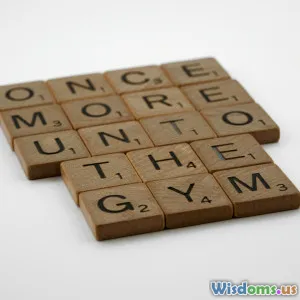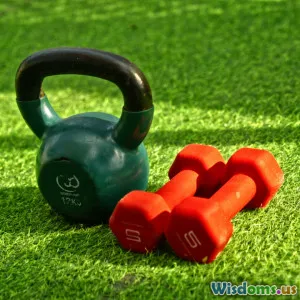
Physical Activity: Key to a Fulfilling Life
8 min read Explore how physical activity fuels a richer, healthier life with science-backed benefits and practical insights. (0 Reviews)
Physical Activity: Key to a Fulfilling Life
Introduction
Imagine unlocking a secret that enhances your happiness, boosts your health, and enriches your overall well-being. That secret is physical activity. It’s far more than just exercise or a fitness trend—engaging in regular physical movement is a vital cornerstone for a fulfilling life. But why is movement so transformative? Why does the science of sports and health emphasize it as a key to living well?
This article delves deeply into the compelling evidence and real-world insights that show how physical activity shapes our bodies, minds, and social connections. Drawing on the latest findings and practical examples, we’ll explore why integrating movement into daily life empowers individuals to thrive, not just survive.
Understanding Physical Activity Beyond Exercise
Physical activity encompasses any bodily movement produced by skeletal muscles that requires energy expenditure, including walking, cycling, gardening, or playing. The World Health Organization recommends at least 150 minutes of moderate-intensity or 75 minutes of vigorous-intensity aerobic activity weekly for adults.
However, the value of physical activity transcends meeting guidelines—it influences multiple dimensions of human life, offering profound benefits that contribute to fulfillment.
Physical Health Benefits: A Foundation for Vitality
Cardiovascular and Metabolic Health
Engaging regularly in physical activity strengthens the heart muscle, improves circulation, and aids in maintaining healthy blood pressure and cholesterol levels. Research published in the American Heart Association Journal found that just 30 minutes of moderate exercise five days a week can reduce the risk of coronary heart disease by up to 40%.
Additionally, physical activity plays a crucial role in managing weight and preventing metabolic conditions like type 2 diabetes. For instance, a study examining middle-aged adults showed that routine physical activity reduced diabetes incidence by approximately 58% compared with sedentary lifestyles.
Strengthening Musculoskeletal Systems
Regular resistance exercises improve muscle mass and bone density, crucial in preventing osteoporosis and frailty especially with aging. A Harvard Medical School report highlights that weight-bearing activities like walking and strength training combat age-related muscle loss, which supports mobility and independence.
Enhancing Immune Function
A lesser-known benefit is exercise’s role in promoting immune resilience. Moderate physical activity stimulates immune surveillance, reducing infection risk and improving recovery rates from illnesses, as noted by research in the British Journal of Sports Medicine.
Mental Health and Cognitive Advantages: Enriching the Mind
Mood Elevation and Stress Reduction
Exercise stimulates endorphin release—natural mood lifters—helping alleviate depression and anxiety. Serial studies, including one from the National Institute of Mental Health, show that consistent physical activity is linked to a 30% reduction in reported depressive symptoms.
Moreover, movement lowers cortisol levels (stress hormones), mitigating chronic stress that often undermines mental well-being.
Cognitive Function, Memory, and Neuroplasticity
Physical activity boosts brain-derived neurotrophic factor (BDNF), a protein integral to neuroplasticity—the brain’s ability to adapt and learn. This has profound implications for memory, learning, and slowing cognitive decline.
Longitudinal studies, such as the Cardiovascular Health Study, report that active seniors demonstrate significantly better memory and executive function, highlighting exercise as preventative against dementia.
Sleep Quality
Activity, especially aerobic and outdoor exercises, promotes better sleep patterns, consolidating rest phases essential for mental health restoration.
Social and Emotional Dimensions: Building Connections
Group Sports and Team Activities
Participation in organized sports fosters a sense of community, teamwork, and shared purpose. These social bonds are essential for emotional fulfillment and combating loneliness.
Take, for example, community running clubs or local soccer teams, which not only motivate continual activity but also establish meaningful friendships and support networks.
Increased Self-Esteem and Confidence
Achievement through mastery and physical improvements empowers individuals, contributing to higher self-worth. This positive self-perception is vital for fulfilling relationships and professional success.
Real-World Insights: Stories That Inspire
Consider the story of Jane Fonda, an actress who launched her career into fitness legend by promoting aerobic exercise in her 60s and 70s, highlighting that physical activity can empower people at any age.
Similarly, research involving Parkinson’s disease patients shows that engaging in adapted physical activities significantly enhances quality of life and independence, as reported by the Parkinson’s Foundation.
Getting Started: Making Physical Activity a Lifelong Habit
Tailor Activity to Individual Preferences and Goals
Whether it’s dancing, swimming, hiking, or yoga, the key is choosing enjoyable activities to ensure sustainable engagement.
Set Realistic and Incremental Goals
Building up from small, achievable steps reduces burnout and injury risk, enhancing long-term adherence.
Leverage Technology and Community Resources
Wearables, fitness apps, and local clubs provide structure, motivation, and accountability.
Conclusion
Physical activity is more than a tool for physical fitness; it is a dynamic force that enriches every aspect of human life—body, mind, and spirit. By fostering cardiovascular health, elevating mood and cognitive function, and connecting us socially, movement becomes a cornerstone of happiness and fulfillment.
From scientific evidence to inspiring real-life examples, the message is clear: prioritizing regular physical activity is an actionable, accessible key to unlocking a more vibrant and meaningful existence. The path to a fulfilling life need not be complicated—just get moving.
Embark on your journey today and discover how this simple yet powerful habit can transform your life forever.
References:
- Warburton, D.E., Nicol, C.W., & Bredin, S.S. (2006). Health benefits of physical activity: the evidence. CMAJ, 174(6), 801-809.
- Pedersen, B.K., & Saltin, B. (2015). Exercise as medicine - evidence for prescribing exercise as therapy in 26 different chronic diseases. Scandinavian Journal of Medicine & Science in Sports, 25, 1-72.
- National Institute of Mental Health. (2020). Exercise and depression.
- Harvard Health Publishing. (2021). Strength training: How-to guide.
- British Journal of Sports Medicine. (2019). Exercise and immune function.
- Parkinson’s Foundation. (2021). Physical activity and Parkinson’s disease.
Rate the Post
User Reviews
Popular Posts





















